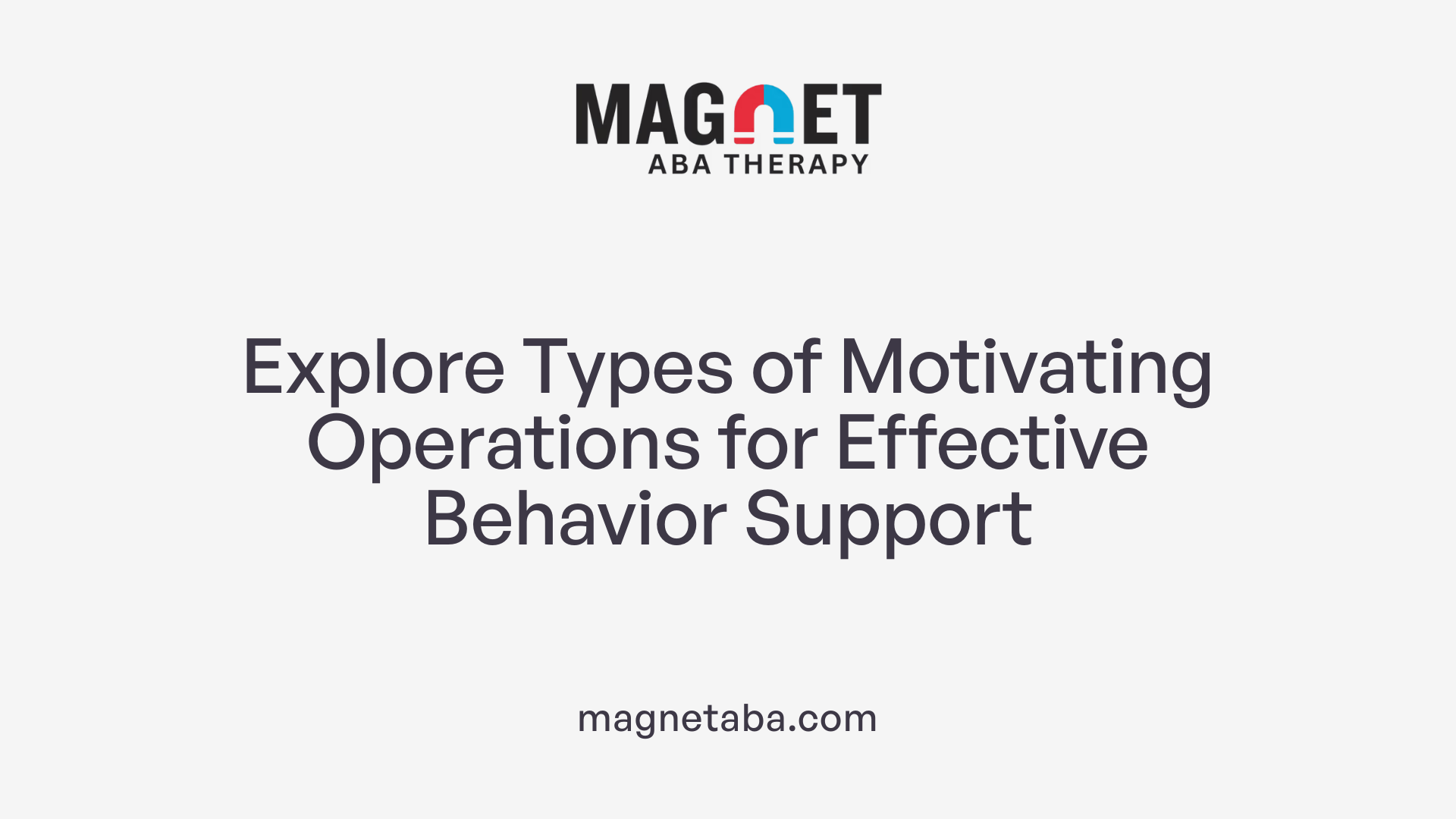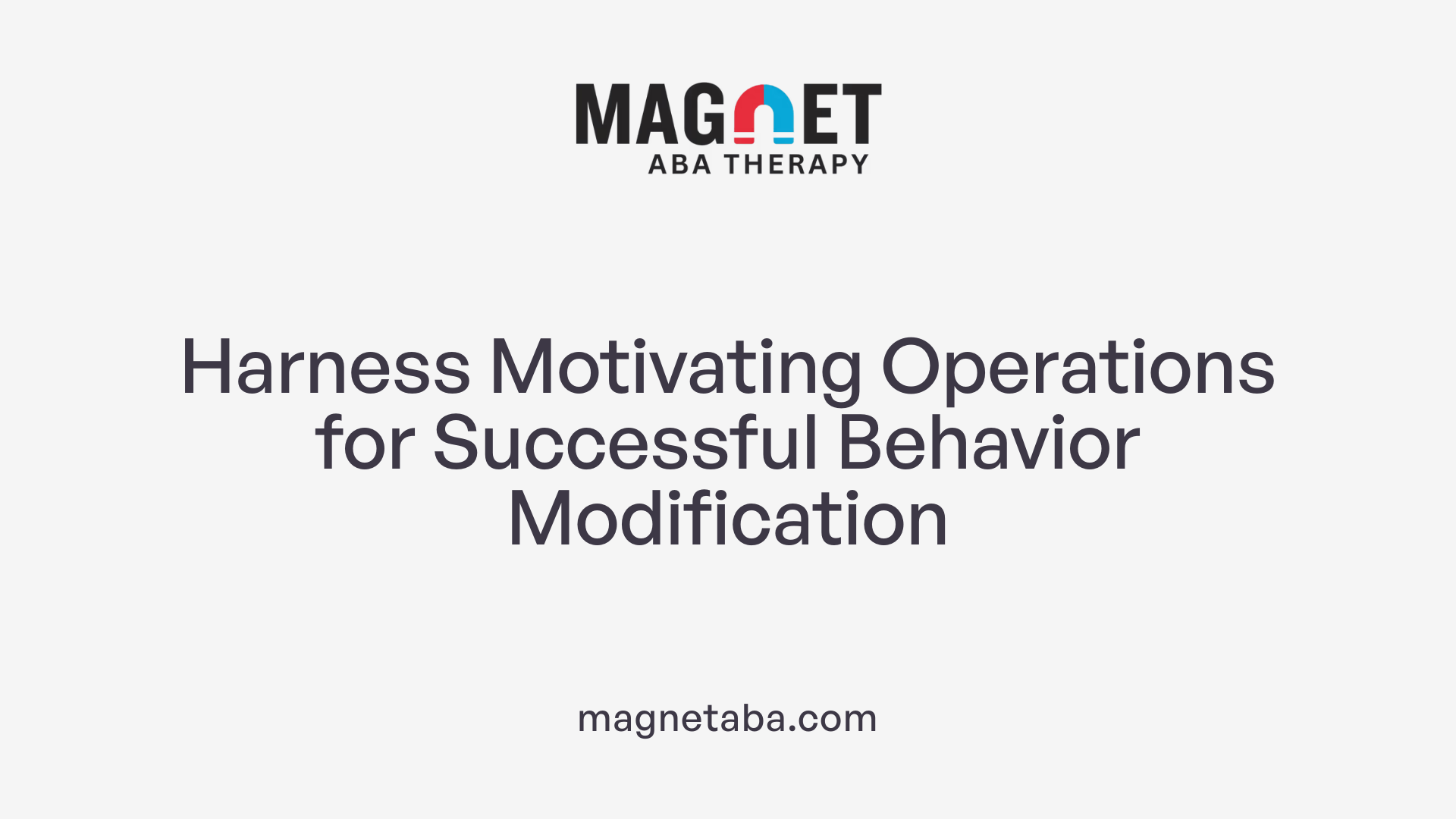Unlocking the Power of Motivating Operations in ABA
Motivating operations (MOs) are central to the science of applied behavior analysis (ABA) because they explain how environmental variables influence the desirability of reinforcers and, consequently, behavior. First introduced in the 1980s, MOs help practitioners predict and modify reactions in various contexts, especially in interventions with children with autism. This article explores the fundamental nature of motivating operations, their types, their influence on behavior, and their practical applications within ABA therapy.
What Are Motivating Operations in ABA?
What are motivating operations in ABA?
Motivating operations (MOs) are environmental events or conditions that impact how desirable or effective a reinforcer or punisher is at a given moment. In applied behavior analysis (ABA), understanding MOs helps explain why certain behaviors happen and how to influence them.
MOs can be unconditioned, meaning they are innate and related to biological needs like hunger or thirst. For example, a child's hunger increases the value of food as a reinforcer, making the child more likely to seek out and consume food. On the other hand, conditioned MOs are learned through experience. These include stimuli like stickers or praise, which become motivators because they have been paired with positive outcomes.
MOs influence behavior in two main ways. First, they alter the value of a stimulus as a reinforcer or punisher—a process known as the value-altering effect. For example, feeling very thirsty makes water more desirable. Second, they affect how often a behavior occurs by increasing or decreasing its likelihood, known as the behavior-altering effect.
Since their introduction in the 1980s, the concept of MOs has evolved significantly. Researchers have classified MOs further into types such as establishing operations (which increase the effectiveness of reinforcers), abolishing operations (which decrease their effectiveness), and other subtypes like surrogate and transitive MOs. These classifications aid practitioners in designing effective interventions.
Overall, MOs are crucial in ABA because they help explain fluctuations in motivation and guide strategies to promote desired behaviors or reduce problematic ones. By adjusting environmental conditions and understanding what motivates a child at a particular moment, therapists can better tailor their approaches to support learning and behavior change.
| Type of MO | Effect on Reinforcer | Example | Category |
|---|---|---|---|
| Establishing Operations (EOs) | Increase effectiveness | Hunger making food more appealing | Unconditioned or conditioned |
| Abolishing Operations (AOs) | Decrease effectiveness | Being full reduces hunger for food | Unconditioned or conditioned |
| Surrogate CMO | Paired with another MO | Praise becomes motivating through pairing | Conditioned |
| Reflexive CMO | Signals worsening or improving conditions | Pet carrier signaling vet visit | Conditioned |
| Transitive CMO | Establishes stimulus as a reinforcer | Clogged toilet increasing plunger value | Conditioned |
Understanding and managing MOs play a vital role in effective ABA interventions, especially in children with autism, where motivation can greatly influence learning and behavior change.
Different Types of Motivating Operations in ABA
 In applied behavior analysis (ABA), motivating operations (MOs) are crucial for understanding how environmental events influence behavior by altering the value of reinforcers or punishers. These influences are instrumental in shaping and modifying behavior effectively.
In applied behavior analysis (ABA), motivating operations (MOs) are crucial for understanding how environmental events influence behavior by altering the value of reinforcers or punishers. These influences are instrumental in shaping and modifying behavior effectively.
Classification of MOs into unconditioned and conditioned is fundamental. Unconditioned motivating operations (UMOs) are innate and do not require learning. They include basic physiological states necessary for survival, such as hunger, thirst, sleep, or relief from the bladder or bowels. For instance, hunger naturally increases the desirability of food, making behaviors aimed at obtaining food more likely.
Conditioned motivating operations (CMOs), by contrast, are learned through experience and association. They derive their motivational significance from prior learning rather than innate drives. CMOs are further divided into three subtypes:
| Subtype | Description | Example |
|---|---|---|
| Surrogate CMO | Acquires MO effects through pairing with an unconditioned or existing CMO | A sticker paired with praise that later functions as a motivator for praise |
| Reflexive CMO | Signals upcoming aversive or aversive-like events, indicating a worsening or improving condition | A pet carrier signals a vet visit, increasing stress-related behaviors |
| Transitive CMO | Establishes the effectiveness of a stimulus as a reinforcer by making it more desirable | A clogged toilet increases the value of a plunger as the solution |
For example, a surrogate CMO might involve a familiar object like a reward card that, through pairing, begins motivating a child to request preferred items. Reflexive CMOs indicate situations like a loud noise signaling impending discomfort, thereby increasing the likelihood of escape behaviors. Transitive CMOs, such as a key establishing the need to unlock a door, make certain objects more desirable.
Understanding these classifications allows clinicians and teachers to tailor environments to evoke desired behaviors and reduce problematic ones. Using motivational operations strategically can enhance learning and compliance by making relevant reinforcers more effective or decreasing the appeal of undesired behaviors.
In summary, the different types of motivating operations—unconditioned and conditioned, with subtypes of surrogate, reflexive, and transitive—play a vital role in behavioral interventions. Recognizing their functions helps in designing precise strategies that manipulate motivation to produce better outcomes in ABA therapy and educational settings.
How Motivating Operations Influence Behavior in ABA
 Motivating operations (MOs) play an essential role in shaping behavior within applied behavior analysis (ABA). They are events or conditions that temporarily change how effective a reinforcer or punisher will be, directly affecting the likelihood of specific behaviors.
Motivating operations (MOs) play an essential role in shaping behavior within applied behavior analysis (ABA). They are events or conditions that temporarily change how effective a reinforcer or punisher will be, directly affecting the likelihood of specific behaviors.
When an MO increases the desirability or effectiveness of a reinforcer, it is called an establishing operation (EO). For example, hunger is a natural EO that makes food more attractive and increases behaviors like asking for or reaching for food. Similarly, thirst increases the appeal of water, motivating behaviors that seek hydration.
On the other hand, abolishing operations (AOs) decrease the value of a reinforcer, making related behaviors less likely. An example of an AO is satiation, such as when someone has eaten enough food, reducing their motivation to seek additional food. Fatigue can also serve as an AO, decreasing the likelihood of engaging in energy-demanding behaviors.
The impact of MOs extends to how reinforcement programs are structured. By adjusting the motivational state—for example, creating hunger before a training session—practitioners can boost engagement and learning. Conversely, reducing motivation by satiation can help diminish problem behaviors that are maintained by certain reinforcers.
Understanding how MOs function helps in tailoring interventions to meet individual needs. For children with autism, for instance, recognizing their unique motivators allows for more effective teaching of communication skills and new behaviors.
Behavioral effects of MOs include an increase or decrease in the likelihood of behaviors based on the current motivational context. For example, depriving a child of a preferred toy will heighten their motivation to request or interact with it. Conversely, recent access to the toy might serve as a satiation, lowering the child's interest in play involving that toy.
In summary, MOs are powerful tools that influence behavior by changing the current value of stimuli. Proper application and assessment of motivating operations can lead to more effective and personalized behavioral interventions.
Table: Examples of Motivating Operations and Their Effects
| Type | Example | Effect on Behavior | Explanation |
|---|---|---|---|
| Establishing Operation | Hunger | Increased | Enhances the value of food as a reinforcer, prompting seeking behaviors |
| Establishing Operation | Thirst | Increased | Makes water more desirable, encouraging drinking behaviors |
| Satiation | Recent eating | Decreased | Reduces motivation to seek food, leading to less eating behavior |
| Transitive CMO | Clogged toilet | Increased | Establishes the toilet plunger as an effective reinforcer for unclogging |
| Surrogate CMO | Cold weather paired with hot cocoa | Increased | Learns to seek hot cocoa as a comfort-related reinforcer |
| Reflexive CMO | Pet carrier before vet visit | Decreased | Signals an upcoming unpleasant event, reducing behaviors like seeking comfort |
Recognizing these influences allows practitioners to manipulate environmental conditions to support skill development and reduce problem behaviors effectively.
The Crucial Role of Motivating Operations in Behavior Modification

What is the significance of motivating operations in behavior change?
Motivating operations (MOs) are essential tools in behavior analysis because they influence how motivating a stimulus is and how likely a behavior is to occur. They change the value of reinforcers or punishers, making behaviors more or less probable depending on the environmental context.
There are two main types of MOs: unconditioned and conditioned. Unconditioned MOs, such as hunger or thirst, are innate and naturally motivate behavior without prior learning. Conditioned MOs, on the other hand, are learned through experience, such as a favorite toy or praise, which then alter motivation.
MOs play a crucial role in behavior change strategies because they can either increase (via establishing operations, EOs) or decrease (via abolishing operations, AOs) the effectiveness of stimuli as reinforcers or punishers. For example, depriving a child of food (an EO) enhances the value of food, encouraging requesting behaviors. Conversely, feeding a child to satiety (an AO) reduces the drive to seek food.
By manipulating environmental factors—like implementing deprivation or satiation—clinicians and educators can modify motivation levels. This targeted approach enhances the likelihood of desired behaviors occurring and reduces the frequency of undesired or problem behaviors.
Understanding and applying MOs allows professionals to design more effective interventions. When they recognize how changes in environment affect motivation, they can tailor reinforcement strategies to support learning, skill development, and behavior reduction. For instance, providing access to favorite items before teaching new skills can naturally increase engagement and cooperation.
Research supports this approach. Studies show that controlling motivating operations, such as offering or withholding preferred items, successfully influences behavior. In educational settings, this method has been used to reduce problem behaviors and promote academic engagement in children with autism.
In summary, motivating operations are invaluable for understanding and leveraging environmental variables. They enable precise control over what motivates behavior, making interventions more efficient, personalized, and effective.
How do MOs influence behavior change strategies?
Using MOs wisely involves assessing each child's unique motivations and adjusting environmental conditions accordingly. This may include scheduled deprivation or providing immediate access to preferred stimuli at strategic moments. As a result, behavior interventions become more responsive and adaptable, leading to better learning outcomes.
Applying Motivating Operations in ABA Therapy

How are motivating operations applied practically in ABA therapy?
In applied behavior analysis (ABA), motivating operations (MOs) serve as tools to modify the effectiveness of reinforcers and influence children's behaviors. Practically, therapists manipulate environmental variables to make certain reinforcers more desirable, thereby encouraging targeted behaviors. For instance, withholding access to a child's preferred toy can create an establishing operation, increasing the likelihood that the child will request or seek out that toy.
Timing and adjusting these MOs are crucial for optimal learning outcomes. Therapists often use preference assessments to identify what motivates each child individually. They might implement deprivation strategies, such as limiting access to specific foods or activities before a session, to elevate motivation. Conversely, satiation can reduce undesired behaviors by allowing the child to satisfy their needs.
By strategically managing these motivational states, clinicians can enhance the effectiveness of teaching sessions, promote skill acquisition, and reduce problem behaviors. Continual observation and data collection ensure that MOs are adjusted as the child's motivations evolve, maintaining a dynamic and responsive approach to therapy.
Strategies for manipulating MOs in therapy
- Using deprivation to increase desirability of reinforcement.
- Applying satiation to reduce problematic behaviors.
- Timing interventions around peak motivation periods.
- Tailoring MOs based on preference assessments.
Examples such as withholding preferred items
A common example is withholding access to a preferred drink to motivate toilet training. When a child is thirsty, water becomes more reinforcing, increasing the likelihood that the child will attempt to communicate or participate in toilet training activities. Another case involves waiting until a child is playing with a favored toy before teaching color identification, leveraging their interest to reinforce learning.
Timing and adjustment of MOs for optimal learning
Effective use of MOs requires careful timing—embedding them in moments when they can exert maximum influence on behavior. Adjustments are made based on ongoing data, such as increasing deprivation if a child’s motivation diminishes or providing satiation if a behavior persists excessively. This responsive approach ensures that interventions remain effective and contextually appropriate, fostering better skill development and behavior management.
Harnessing Motivation for Better Outcomes in ABA
Motivating operations are a foundational concept in ABA that empower practitioners to understand and manipulate the factors driving behavior. By strategically adjusting environmental conditions—such as creating deprivation or satiation states—therapists can influence the effectiveness of reinforcers and punishers and guide behavior change more effectively. Recognizing the distinction between unconditioned and conditioned MOs, and their subtypes, allows for more precise interventions tailored to individual needs. Overall, a thorough understanding and application of motivating operations enhance the efficacy of ABA therapy, promoting meaningful, lasting behavioral improvements.
References
- What are Motivating Operations (MOs)? | Autism Resources
- B-12: Define and provide examples of motivating operations
- A Tutorial on the Concept of the Motivating Operation and its ...
- Motivating Operations in ABA Therapy: What, When & How
- Motivating Operation - Study Notes ABA
- EFFECTS OF MOTIVATING OPERATIONS ON PROBLEM AND ...
- B.16 Examples of Motivating Operations - AllDayABA











